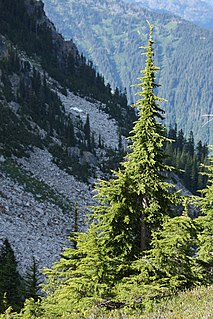
Pseudotsuga menziesii is an evergreen conifer species in the pine family, Pinaceae. It is native to western North America and is known as Douglas fir, Douglas-fir, Oregon pine, and Columbian pine. There are two varieties: coast Douglas-fir, and Rocky Mountain Douglas-fir.

Oxalis oregana is a species of the wood sorrel family, Oxalidaceae, native to moist Douglas-fir and coast redwood forests of western North America from southwestern British Columbia, Washington, Oregon, and California.

Tsuga heterophylla, the western hemlock or western hemlock-spruce, is a species of hemlock native to the west coast of North America, with its northwestern limit on the Kenai Peninsula, Alaska, and its southeastern limit in northern Sonoma County, California.

Tsuga mertensiana, known as mountain hemlock, is a species of hemlock native to the west coast of North America, with its northwestern limit on the Kenai Peninsula, Alaska, and its southeastern limit in northern Tulare County, California. Mertensiana refers to Karl Heinrich Mertens (1796–1830), a German botanist who collected the first specimens as a member of a Russian expedition in 1826-1829.

Abies lasiocarpa, commonly called the subalpine fir or Rocky Mountain fir, is a western North American fir tree.

Rubus leucodermis, called white bark raspberry is a species of Rubus native to western North America, from Alaska south as far as California, Arizona, New Mexico, and Chihuahua.

Vaccinium parvifolium, the red huckleberry, is a species of Vaccinium native to western North America, where it is common in forests from southeastern Alaska and British Columbia south through western Washington and Oregon to central California.

Rhododendron macrophyllum, the Pacific rhododendron, California rosebay, California rhododendron, coast rhododendron or big leaf rhododendron, is a large-leaved species of Rhododendron native to the Pacific Coast of North America. It is the state flower of Washington.

Malus fusca, with the common names Oregon crabapple and Pacific crabapple, is a North American species of crabapple.

Vaccinium ovalifolium is a plant in the heath family having three varieties, all of which grow in northerly regions, including the subarctic.

Sedum divergens, commonly called spreading stonecrop, Cascade stonecrop, and Pacific stonecrop, is a low growing flowering plant of the genus Sedum. It is native to western North America from Alaska to northern California. This plant is common in the lava beds of Northwest British Columbia where it is one of the food plants of the Nisga'a first nation.

Sedum lanceolatum is a species of flowering plant in the stonecrop family known by the common names spearleaf stonecrop and lanceleaf stonecrop.
Sedum oblanceolatum is a species of flowering plant in the stonecrop family known by the common names oblongleaf stonecrop and Applegate stonecrop. It is native to the Klamath Mountains of southwestern Oregon and far northern California, where it grows on many types of rocky substrate, such as serpentine soils and other ultramafics. It is a succulent plant forming basal rosettes of waxy leaves. The leaves are widely lance-shaped, widest near the distal end and narrowing to rounded or notched tips. Smaller leaves occur farther up the stem. The small inflorescence grows a few centimeters tall and bears up to 50 flowers in a flat-topped array. The flowers have cream or yellowish petals up to a centimeter long.

Sedum obtusatum is a species of flowering plant in the stonecrop family known by the common name Sierra stonecrop. It is native to the Sierra Nevada and adjacent high mountain ranges of California, its distribution extending north into Oregon and east into Nevada. It grows in rocky mountain habitat.

Sedum oregonense is a species of flowering plant in the stonecrop family known by the common name cream stonecrop. It is native to the Klamath Ranges of southern Oregon and northern California, where it grows in rocky habitat. It is a succulent plant forming basal rosettes of leaves up to about 4 centimeters long. Smaller leaves occur farther up the stem. The leaves are green in color and waxy in texture. The inflorescence is an erect, wide open array of many flowers. The flowers have yellow petals with red-tinged or white-speckled undersides.
Sedum radiatum is a species of flowering plant in the stonecrop family known by the common name Coast Range stonecrop. It is native to Oregon and California, where it is known from several coastal and inland mountain ranges, including the Klamath Mountains and the Sierra Nevada. It grows in many types of rocky habitat, sometimes on serpentine soils. It is an annual or biennial succulent plant producing several stems with elevated, somewhat basal rosettes of leaves. The leaves are not much more than a centimeter long. They are green or yellowish with green, purple or red veining. The inflorescence is a short, erect array of many densely packed flowers. The flowers have yellow, cream, or white petals which are lance-shaped and one half to 1 centimeter long.
Sedum moraniii is a rare species of flowering plant in the stonecrop genus known by the common name Rogue River stonecrop. It is endemic to Oregon in the United States, where it only grows in Josephine County next to the Rogue River.

Galium oreganum is a plant species in the Rubiaceae family. It is native to British Columbia, Washington, Oregon, and northern California.

Alectoria sarmentosa is a long-lived, perennial lichen. It is also sometimes classified as a fungus. It is a light greenish colored and fruticose or bushy bodied. This epiphytic lichen belonging to the Alectoriaceae family and the suborder Lecanorineae, which includes six similar species. A. sarmentosa grows draped or strung over conifer tree limbs and deciduous shrub branches in Northern temperate rainforest. This lichen favors mature and old growth, wet conifer and hardwood forests with clean air. A. sarmentosa is sensitive to air pollution and used for air quality monitoring. Areas required by A. sarmentosa are found in northern and southern temperate zones and receive high rainfall. This lichen is commonly found in transitional areas between valley and mountainous forests, but usually avoiding the immediate coast.



















